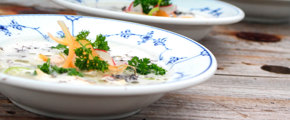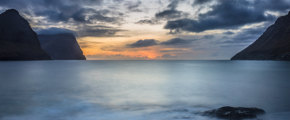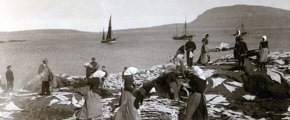Atlantic cod
The Atlantic cod is renowned for its delicate taste and the brilliant white colour of its flesh, which all but glows on the plate. Atlantic cod has been a highly prized fish throughout the ages.
From being a provision for Vikings sailing across the North Atlantic and a welcomed meal for Catholics fasting in Southern Europe during Lent, to starring on the menus of the very best gourmet restaurants today, the versatile cod is a fish for everyone.
The Atlantic cod has a flesh that is light and flaky with an exceptionally clean white colour, and its delicate taste is mild and slightly sweet. The whiteness of the cod is typical for the muscle tissue of fish that swim in weightlessness close to the ocean floor. The cod has nearly no fat and is rich in protein, a healthy food that contains Omega-3 fatty acids and vitamins A and D.
Atlantic cod can be prepared in a multitude of different ways, such as fried or cooked in fillets, as well as whole, and it is also excellent smoked. Just about every part of the cod can be eaten. In the Faroe Islands, the cod’s cheeks and chin are eaten as delicacies.
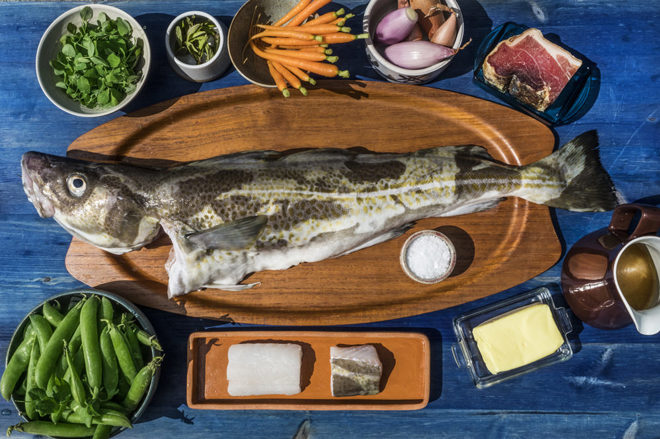
Try Faroese chef Gutti Winther's recipe for poached cod with French style peas.
Biology
The Atlantic cod (Gadus morhua) can be recognised by a distinct “beard” barbel under the chin. It uses this to feel its way across the seabed. The cod has a greyish brown or yellowy green colour on its back and sides and the stomach is white or a light grey. It has closely spaced dark spots all over and a white stripe that runs along its sides.
The colour of the skin can vary depending on the cod’s environment. The Atlantic cod has three dorsal fins evenly spaced across the back, with a pelvic fin and a posterior fin towards the back of the stomach. The Atlantic cod will usually be around 50-120 cm in length but can grow up to 200 cm long.
The codfish family encompasses over 200 separate sub-groups that are spread all over the northern hemisphere. The Atlantic cod is a demersal fish and mostly keeps to the ocean floor. It can be found at depths of around 35-40 metres and will rarely go below 600 metres.
The Atlantic cod is a robust fish. Cod tolerate well the cold and prefer waters with a temperature between 2 and 10 degrees Celsius.
Cod are carnivores and opportunistic eaters that will prey on just about anything. They will even eat smaller cod. The Atlantic cod mostly eats the animals that gather where warm and cold currents merge, such as they do around the Faroe Islands.
The Faroe Islands lie in the heart of the North Atlantic, on the perimeter of the Arctic. The waters around the Faroe Islands are one of the cleanest marine environments on the planet, with a steady temperature and more than enough food, ideal for fish such as cod.
In Faroese waters there are two distinct stocks of Atlantic cod, the Faroe Shelf cod and the Faroe Bank cod. In the Faroe Islands cod in called toskur.
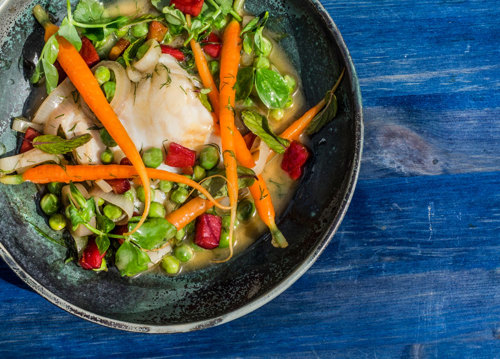
Viking Provision
The Faroese have been wind drying cod for a very long time as a method of preserving the fish. Cod will shrink about 80% in size when dried, due to water evaporation and the compacting of the flesh. Left behind is dried fish that is nearly pure protein.
The Faroese are descended from the Norsemen who settled the Faroe Islands during the 800’s. The Vikings travelled far and wide, across the North Atlantic and through Arctic waters. They even ventured all the way to North America. Dried cod is rich in nutrients but takes up very little space. This made it the perfect provision to take on long Viking journeys.
Southern Europeans have loved cod since the Middle Ages and they mostly eat salted cod. In addition to the delicious taste of salted cod, it is also a welcomd alternative during Lent, when traditionally Catholics were not allowed to eat meat. Salted cod is the main ingredient in renowned southern dishes such as brandade de morue, bacalhau à gomes de sa and pil pil.
The Faroese have a long and proud tradition of salting fish. When the Faroe Islands emerged as a fisheries nation in the 19th century, the Faroese mainly produced salted fish that was exported to southern Europe.
The Faroese still produce and export salted fish. It is highly valued in countries such as Spain, where the terms Islas Feroe (Faroe Islands) and Bacalao Faroe are synonymous with great quality and first class salted fish.
Read about Faroese salted fish.
The Faroese fish for Atlantic cod with trawls, longlines and jigging reels. Besides fishing in Faroese waters, the Faroe Islands have agreements to fish for Atlantic cod in Iceland, the Barents Sea, East Greenland, the Norwegian Sea and on the Flemish Cap.

